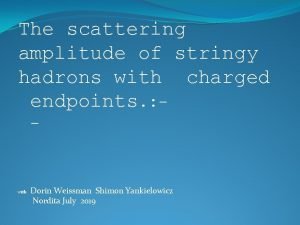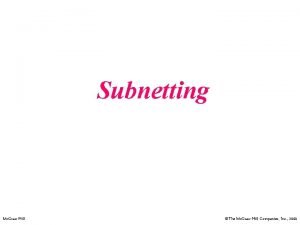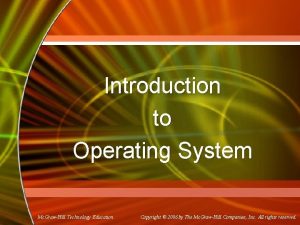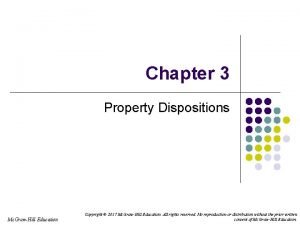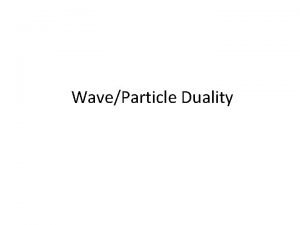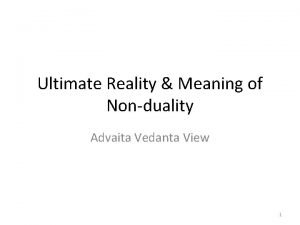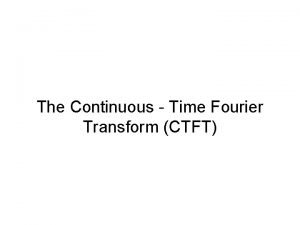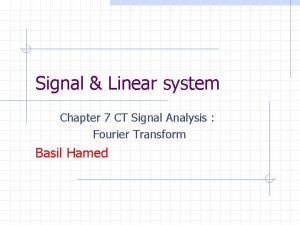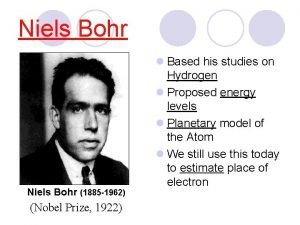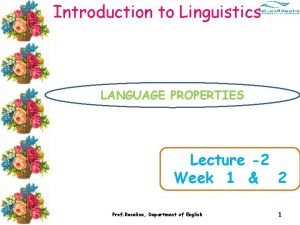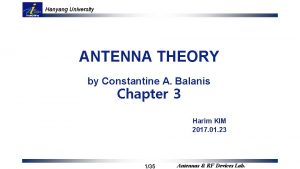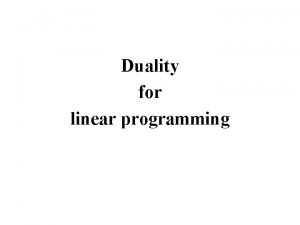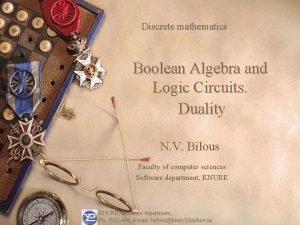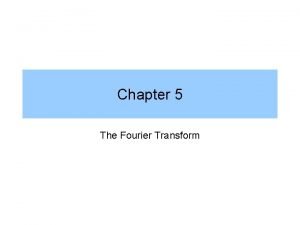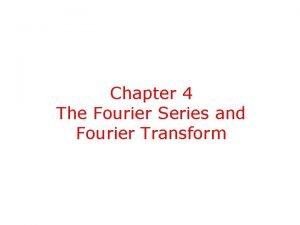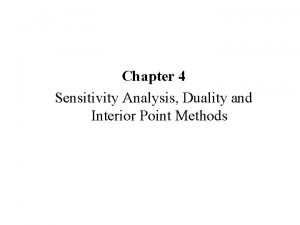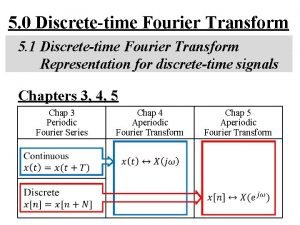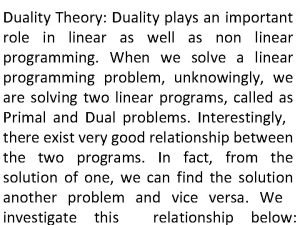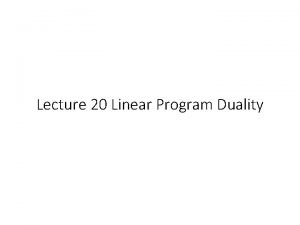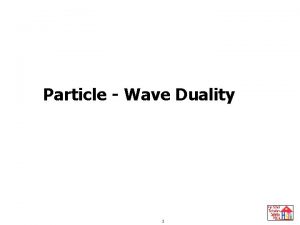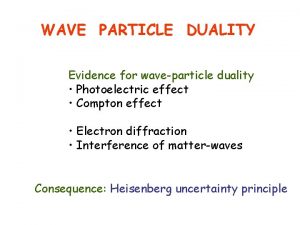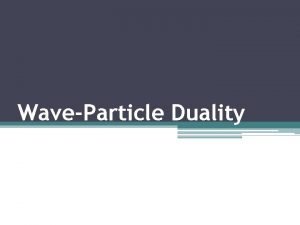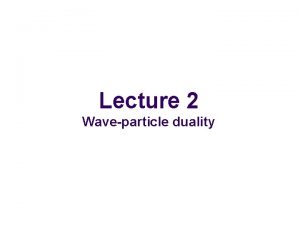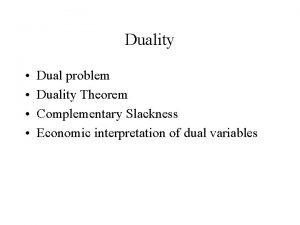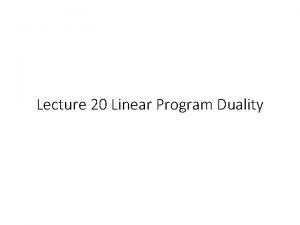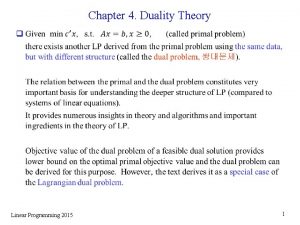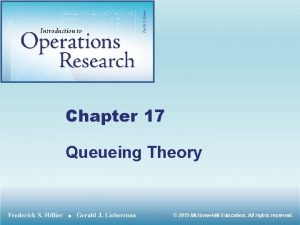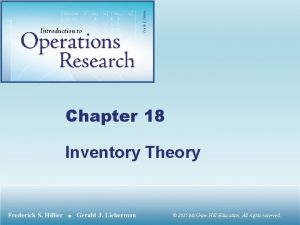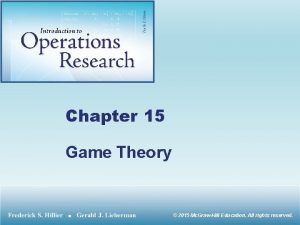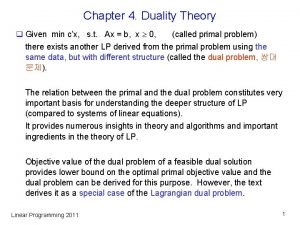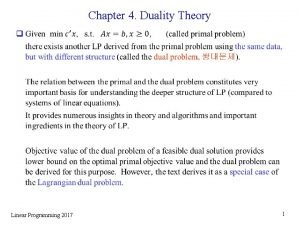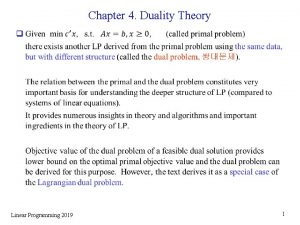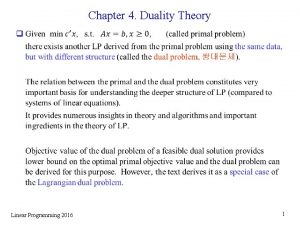Chapter 6 Duality Theory 2015 Mc GrawHill Education






























- Slides: 30

Chapter 6 Duality Theory © 2015 Mc. Graw-Hill Education. All rights reserved.

6. 1 The Essence of Duality Theory • Every linear programming problem has an associated problem called the dual – Original problem is known as the primal – These relationships prove useful in a variety of ways • Consider a maximization primal problem in standard form – Dual is a minimization problem – Dual uses same parameters in different locations © 2015 Mc. Graw-Hill Education. All rights reserved. 2

The Essence of Duality Theory © 2015 Mc. Graw-Hill Education. All rights reserved. 3

The Essence of Duality Theory • Coefficients in the objective function of the primal problem: – Are right-hand sides of the functional constraints in the dual problem • Right-hand sides of the functional constraints in the primal problem: – Are the coefficients in the objective function of the dual problem © 2015 Mc. Graw-Hill Education. All rights reserved. 4

The Essence of Duality Theory • Coefficients of a variable in the functional constraints of the primal problem: – Are the coefficients in a functional constraint of the dual problem © 2015 Mc. Graw-Hill Education. All rights reserved. 5

© 2015 Mc. Graw-Hill Education. All rights reserved. 6

The Essence of Duality Theory © 2015 Mc. Graw-Hill Education. All rights reserved. 7

The Essence of Duality Theory • General relationships between primal and dual problems – Parameters for a functional constraint in either problem are the coefficients of a variable in the other problem – Coefficients in the objective function of either problem are the right-hand sides for the other problem © 2015 Mc. Graw-Hill Education. All rights reserved. 8

The Essence of Duality Theory • Origin of the dual problem – Duality theory based on the fundamental insight presented in Chapter 5 • Summary of primary-dual relationships – Weak duality property – Strong duality property – Complementary solutions property – Complementary optimal solutions property – Symmetry property © 2015 Mc. Graw-Hill Education. All rights reserved. 9

The Essence of Duality Theory • Summary of primary-dual relationships (cont’d. ) – Duality theorem • Weak duality property – If x is a feasible solution for the primal problem and y is a feasible solution for the dual problem, then cx ≤ yb. © 2015 Mc. Graw-Hill Education. All rights reserved. 10

The Essence of Duality Theory • Strong duality property – If x* is an optimal solution for the primal problem and y* is an optimal solution for the dual problem, then cx* = y*b. • Complementary solutions property – At each iteration, the simplex method simultaneously identifies a CPF solution x for the primal problem and a complementary solution y for the dual problem • Where cx = yb © 2015 Mc. Graw-Hill Education. All rights reserved. 11

The Essence of Duality Theory • Complementary solutions property (cont’d. ) – If x is not optimal for the primal problem, then y is not feasible for the dual problem • Complementary optimal solutions property – The simplex method identifies (at its final iteration) an optimal solution x* for the primal problem and a complementary optimal solution y* for the dual problem • Where cx* = y*b © 2015 Mc. Graw-Hill Education. All rights reserved. 12

The Essence of Duality Theory • Symmetry property – For any primal problem and its dual problem • All relationships between them must be symmetric • Duality theorem – Identifies the only possible relationships between the primal and dual problems – If one problem has feasible solutions and a bounded objective function, then so does the other problem • Both weak and strong duality properties apply © 2015 Mc. Graw-Hill Education. All rights reserved. 13

The Essence of Duality Theory • Duality theorem (cont’d. ) – If one problem has feasible solutions and an unbounded objective function, then the other problem has no feasible solutions – If one problem has no feasible solutions, then the other problem either has no feasible solutions or an unbounded objective function © 2015 Mc. Graw-Hill Education. All rights reserved. 14

The Essence of Duality Theory • Applications – Dual problem can be solved directly by the simplex method to identify an optimal solution for the primal problem • Can be useful if one of the problems has fewer functional constraints – Evaluation of a proposed solution for the primal problem – Economic interpretation of the dual problem • Insights for the primal problem © 2015 Mc. Graw-Hill Education. All rights reserved. 15

6. 2 Economic Interpretation of Duality • The dual variable yi – Interpreted as the contribution to profit per unit of resource i when the current set of basic variables is used to obtain the primal solution © 2015 Mc. Graw-Hill Education. All rights reserved. 16

Economic Interpretation of Duality • The simplex method: – Examines all nonbasic variables in the current BF solution • To see which ones can provide a more profitable use of the resources by being increased • If none can, the current solution must be optimal • If one or more can, the simplex method increases this variable (entering basic variable) until marginal value of resources changes • Increase results in a new BF solution and process is repeated © 2015 Mc. Graw-Hill Education. All rights reserved. 17

6. 3 Primal-Dual Relationships • Augmented form of the dual problem – Obtained by subtracting the surplus from the left-hand side of each constraint j – n functional constraints and n + m variables – Each basic solution has n basic variables and m nonbasic variables © 2015 Mc. Graw-Hill Education. All rights reserved. 18

Primal-Dual Relationships • Basic solutions of primal and dual problems have direct correspondence – Key: row 0 of simplex tableau for the primal basic solution – Dual solution read from row 0 is also a basic solution • Complementary basic solutions property – Primal problem basic solution has a complementary basic solution in the dual problem © 2015 Mc. Graw-Hill Education. All rights reserved. 19

Primal-Dual Relationships • Complementary slackness property – Shows how to identify the basic and nonbasic solutions © 2015 Mc. Graw-Hill Education. All rights reserved. 20

Primal-Dual Relationships © 2015 Mc. Graw-Hill Education. All rights reserved. 21

Primal-Dual Relationships © 2015 Mc. Graw-Hill Education. All rights reserved. 22

6. 4 Adapting to Other Primal Forms • Option to convert any model to standard form – Construct dual problem in the usual way • Constructing the dual of the dual yields the primal problem • Symmetry property implies: – It doesn’t matter which problem is called the dual and which is the primal © 2015 Mc. Graw-Hill Education. All rights reserved. 23

Adapting to Other Primal Forms © 2015 Mc. Graw-Hill Education. All rights reserved. 24

Adapting to Other Primal Forms • Sensible-odd-bizarre (SOB) method for determining the form of constraints in the dual – Formulate the primal problem in either maximization or minimization form • Dual problem will be in other form – Label the different forms of the functional and variable constraints as being sensible, odd, or bizarre • See Table 6. 14 for guidance © 2015 Mc. Graw-Hill Education. All rights reserved. 25

Adapting to Other Primal Forms © 2015 Mc. Graw-Hill Education. All rights reserved. 26

Adapting to Other Primal Forms • SOB method (cont’d. ) – For each constraint on an individual variable in the dual problem, use the form with the same label as the corresponding functional constraint in the primal problem – For each functional constraint in the dual problem, use the form with the same label as the constraint on the corresponding individual variable in the primal problem © 2015 Mc. Graw-Hill Education. All rights reserved. 27

6. 5 The Role of Duality in Sensitivity Analysis • Sensitivity analysis involves examining the impact of parameter changes – You can choose which problem to use to investigate each change: primal or dual • Changes in coefficients of a nonbasic variable – Does not affect solution feasibility – May affect whether the solution is optimal © 2015 Mc. Graw-Hill Education. All rights reserved. 28

The Role of Duality in Sensitivity Analysis • Introduction of a new variable – Adds another activity into the model – Implies a new constraint in the dual problem • Question: Is the complementary basic solution for the dual problem still feasible? – To answer this: simply check against the new constraint for the dual problem © 2015 Mc. Graw-Hill Education. All rights reserved. 29

6. 6 Conclusions • Every linear programming problem has a corresponding dual problem • Important relationships exist between the two problems • The simplex method can be applied to either problem – Sometimes dealing with dual problem saves computational effort © 2015 Mc. Graw-Hill Education. All rights reserved. 30
 Holographic duality theory
Holographic duality theory Grawhill
Grawhill Grawhill
Grawhill Grawhill
Grawhill Grawhill
Grawhill Mc grawhill
Mc grawhill Single user multitasking os
Single user multitasking os Grawhill
Grawhill Mc grawhill
Mc grawhill Grawhill
Grawhill What is this language
What is this language Wave particle duality questions
Wave particle duality questions Non duality meaning
Non duality meaning Duality memory locations
Duality memory locations Cftft
Cftft Pengertian dualitas dan contohnya
Pengertian dualitas dan contohnya Duality of fourier transform
Duality of fourier transform Language
Language Niels bohr analogy
Niels bohr analogy Duality in linguistics
Duality in linguistics Recreational function of language
Recreational function of language Duality theorem in antenna
Duality theorem in antenna Jekyll and hyde quotes
Jekyll and hyde quotes Weak duality theorem proof
Weak duality theorem proof Law of duality in discrete mathematics
Law of duality in discrete mathematics Fourier transform duality examples
Fourier transform duality examples Fourier transform of multiplication of two signals
Fourier transform of multiplication of two signals Sensitivity analysis and duality
Sensitivity analysis and duality Difference between communicative and informative signals
Difference between communicative and informative signals Duality of fourier transform
Duality of fourier transform What is duality in accounting
What is duality in accounting
